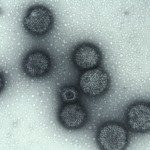Lien vers Pubmed [PMID] – 26656690
J Virol. 2015 Dec 9;90(5):2676-89. doi: 10.1128/JVI.01176-15.
Japanese encephalitis virus (JEV) membrane (M) protein plays important structural roles in the processes of fusion and maturation of progeny virus during cellular infection. The M protein is anchored in the viral membrane, and its ectodomain is composed of a flexible N-terminal loop and a perimembrane helix. In this study, we performed site-directed mutagenesis on residue 36 of JEV M protein and showed that the resulting mutation had little or no effect on the entry process but greatly affected virus assembly in mammalian cells. Interestingly, this mutant virus had a host-dependent phenotype and could develop a wild-type infection in insect cells. Experiments performed on infectious virus as well as in a virus-like particle (VLP) system indicate that the JEV mutant expresses structural proteins but fails to form infectious particles in mammalian cells. Using a mouse model for JEV pathogenesis, we showed that the mutation conferred complete attenuation in vivo. The production of JEV neutralizing antibodies in challenged mice was indicative of the immunogenicity of the mutant virus in vivo. Together, our results indicate that the introduction of a single mutation in the M protein, while being tolerated in insect cells, strongly impacts JEV infection in mammalian hosts.
IMPORTANCE:
JEV is a mosquito-transmitted flavivirus and is a medically important pathogen in Asia. The M protein is thought to be important for accommodating the structural rearrangements undergone by the virion during viral assembly and may play additional roles in the JEV infectious cycle. In the present study, we show that a sole mutation in the M protein impairs the JEV infection cycle in mammalian hosts but not in mosquito cells. This finding highlights differences in flavivirus assembly pathways among hosts. Moreover, infection of mice indicated that the mutant was completely attenuated and triggered a strong immune response to JEV, thus providing new insights for further development of JEV vaccines.



